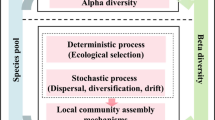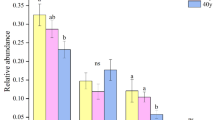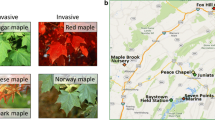Abstract
Fungal communities are essential to the maintenance of soil multifunctionality. Plant invasion represents a growing challenge for the conservation of soil biodiversity across the globe, but the impact of non-native species invasion on fungal diversity, community structure, and assembly processes remains largely unknown. Here, we examined the diversity, community composition, functional guilds, and assembly process of fungi at three soil depths underneath a native species, three non-native species, and a bare tidal flat from a coastal wetland. Plant species was more important than soil depth in regulating the diversity, community structure, and functional groups of fungi. Non-native species, especially Spartina alterniflora, increased fungal diversity, altered fungal community structure, and increased the relative abundance of saprotrophic and pathogenic fungi in coastal wetland soils. Stochastic processes played a predominant role in driving fungal community assembly, explaining more than 70% of the relative contributions. However, compared to a native species, non-native species, especially S. alterniflora, reduced the relative influence of stochastic processes in fungal community assembly. Collectively, our results provide novel evidence that non-native species can increase fungal diversity, the relative abundance of saprotrophic and pathogenic fungi, and deterministic processes in the assembly of fungi in coastal wetlands, which can expand our knowledge of the dynamics of fungal communities in subtropical coastal wetlands.







Similar content being viewed by others
Data Availability
The raw sequences have been deposited in the DNA Data Bank of Japan under accession number DRA014566.
References
Li J, Delgado-Baquerizo M, Wang JT, Hu HW, Cai ZJ, Zhu YN, Singh BK (2019) Fungal richness contributes to multifunctionality in boreal forest soil. Soil Biol Biochem 136:107526
Delgado-Baquerizo M, Reich PB, Trivedi C, Eldridge DJ, Abades S, Alfaro FD, Bastida F, Berhe AA, Cutler NA, Gallardo A (2020) Multiple elements of soil biodiversity drive ecosystem functions across biomes. Nat Ecol Evol 4:210–220
Kim J, Heo YM, Yun J, Lee H, Kim JJ, Kang H (2022) Changes in archaeal community and activity by the invasion of spartina anglica along soil depth profiles of a coastal wetland. Microb Ecol 83:436–446
Yarwood SA (2018) The role of wetland microorganisms in plant-litter decomposition and soil organic matter formation: a critical review. FEMS Microbiol Ecol 94:fiy175
Zhang J, Li T, Jia J, Zhang J, Zhang F (2021) Bacterial taxa and fungal diversity are the key factors determining soil multifunctionality in different cropping systems. Land Degrad Dev 32:5012–5022
Liu M, Feng F, Cai T, Tang S (2022) Fungal community diversity dominates soil multifunctionality in freeze-thaw events. CATENA 214:106241
Li J, Cui L, Delgado-Baquerizo M, Wang J, Zhu Y, Wang R, Li W, Lei Y, Zhai X, Zhao X, Singh BK (2022) Fungi drive soil multifunctionality in the coastal salt marsh ecosystem. Sci Total Environ 818:151673
Zhou J, Ning D (2017) Stochastic community assembly: does it matter in microbial ecology? Microbiol. Mol Biol R 81:e00002-00017
Stegen JC, Lin X, Fredrickson JK, Chen X, Kennedy DW, Murray CJ, Rockhold ML, Konopka A (2013) Quantifying community assembly processes and identifying features that impose them. ISME J 7:2069–2079
Ning D, Yuan M, Wu L, Zhang Y, Guo X, Zhou X, Yang Y, Arkin AP, Firestone MK, Zhou J (2020) A quantitative framework reveals ecological drivers of grassland microbial community assembly in response to warming. Nat Commun 11:4717
Kang L, Chen L, Zhang D, Peng Y, Song Y, Kou D, Deng Y, Yang Y (2022) Stochastic processes regulate belowground community assembly in alpine grasslands on the Tibetan Plateau. Environ Microbiol 24:179–194
Zhang ZF, Pan YP, Liu Y, Li M, Druzhinina IS (2021) High-level diversity of basal fungal lineages and the control of fungal community assembly by stochastic processes in mangrove sediments. Appl Environ Microb 87:e00928-e921
Guo J, Ling N, Chen Z, Xue C, Li L, Liu L, Gao L, Wang M, Ruan J, Guo S, Vandenkoornhuyse P, Shen Q (2020) Soil fungal assemblage complexity is dependent on soil fertility and dominated by deterministic processes. New Phytol 226:232–243
Tripathi BM, Stegen JC, Kim M, Dong K, Adams JM, Lee YK (2018) Soil pH mediates the balance between stochastic and deterministic assembly of bacteria. ISME J 12:1072–1083
Jiao S, Chu H, Zhang B, Wei X, Chen W, Wei G (2022) Linking soil fungi to bacterial community assembly in arid ecosystems. iMeta 1:e2
Li B, Liao CH, Zhang XD, Chen HL, Wang Q, Chen ZY, Gan XJ, Wu JH, Zhao B, Ma ZJ (2009) Spartina alterniflora invasions in the Yangtze River estuary, China: an overview of current status and ecosystem effects. Ecol Eng 35:511–520
Ricciardi A, Blackburn TM, Carlton JT, Dick JT, Hulme PE, Iacarella JC, Jeschke JM, Liebhold AM, Lockwood JL, MacIsaac HJ (2017) Invasion science: a horizon scan of emerging challenges and opportunities. Trends Ecol Evol 32:464–474
Kim J, Chaudhary DR, Lee J, Byun C, Ding W, Kwon BO, Khim JS, Kang H (2020) Microbial mechanism for enhanced methane emission in deep soil layer of Phragmites-introduced tidal marsh. Environ Int 134:105251
Suding KN, Stanley Harpole W, Fukami T, Kulmatiski A, MacDougall AS, Stein C, van der Putten WH (2013) Consequences of plant–soil feedbacks in invasion. J Ecol 101:298–308
Van der Putten WH, Bardgett RD, Bever JD, Bezemer TM, Casper BB, Fukami T, Kardol P, Klironomos JN, Kulmatiski A, Schweitzer JA, Suding KN, Van de Voorde TFJ, Wardle DA (2013) Plant–soil feedbacks: the past, the present and future challenges. J Ecol 101:265–276
Mariotte P, Mehrabi Z, Bezemer TM, De Deyn GB, Kulmatiski A, Drigo B, Veen GF, Van der Heijden MGA, Kardol P (2018) Plant–soil feedback: bridging natural and agricultural sciences. Trends Ecol Evol 33:129–142
Bezabih B, Li J, Yuan J, Yanhong D, Liu D, Chen Z, Kim J, Kang H, Freeman C, Ding W (2022) Non-native plant invasion can accelerate global climate change by increasing wetland methane and terrestrial nitrous oxide emissions. Global Change Biol. https://doi.org/10.1111/gcb.16290
Aldossari N, Ishii S (2021) Fungal denitrification revisited–recent advancements and future opportunities. Soil Biol Biochem 157:108250
Wankel SD, Ziebis W, Buchwald C, Charoenpong C, de Beer D, Dentinger J, Xu Z, Zengler K (2017) Evidence for fungal and chemodenitrification based N2O flux from nitrogen impacted coastal sediments. Nat Commun 8:1–11
Kearns PJ, Bulseco-McKim AN, Hoyt H, Angell JH, Bowen JL (2019) Nutrient enrichment alters salt marsh fungal communities and promotes putative fungal denitrifiers. Microb Ecol 77:358–369
Kulmatiski A, Beard KH, Stevens JR, Cobbold SM (2008) Plant–soil feedbacks: a meta-analytical review. Ecol Lett 11:980–992
Fahey C, Koyama A, Antunes PM, Dunfield K, Flory SL (2020) Plant communities mediate the interactive effects of invasion and drought on soil microbial communities. ISME J 14:1396–1409
Lin Y, Yuan J, Liu D, Kang H, Freeman C, Hu HW, Ye G, Ding W (2021) Divergent responses of wetland methane emissions to elevated atmospheric CO2 dependent on water table. Water Res 205:117682
Li H, La S, Zhang X, Gao L, Tian Y (2021) Salt-induced recruitment of specific root-associated bacterial consortium capable of enhancing plant adaptability to salt stress. ISME J 15:2865–2882
Huang X, Wang J, Dumack K, Liu W, Zhang Q, He Y, Di H, Bonkowski M, Xu J, Li Y (2021) Protists modulate fungal community assembly in paddy soils across climatic zones at the continental scale. Soil Biol Biochem 160:108358
Yang W, Zhang D, Cai X, Xia L, Luo Y, Cheng X, An S (2019) Significant alterations in soil fungal communities along a chronosequence of Spartina alterniflora invasion in a Chinese Yellow Sea coastal wetland. Sci Total Environ 693:133548
Zhang G, Bai J, Tebbe CC, Huang L, Jia J, Wang W, Wang X, Yu L, Zhao Q (2021) Spartina alterniflora invasions reduce soil fungal diversity and simplify co-occurrence networks in a salt marsh ecosystem. Sci Total Environ 758:143667
Wang W, Wang C, Sardans J, Tong C, Jia R, Zeng C, Peñuelas J (2015) Flood regime affects soil stoichiometry and the distribution of the invasive plants in subtropical estuarine wetlands in China. CATENA 128:144–154
Lin Y, Hu HW, Yang P, Ye G (2022) Spartina alterniflora invasion has a greater impact than non-native species, Phragmites australis and Kandelia obovata, on the bacterial community assemblages in an estuarine wetland. Sci Total Environ 822:153517
Lin Y, Ye G, Liu D, Ledgard S, Luo J, Fan J, Yuan J, Chen Z, Ding W (2018) Long-term application of lime or pig manure rather than plant residues suppressed diazotroph abundance and diversity and altered community structure in an acidic Ultisol. Soil Biol Biochem 123:218–228
Lin Y, Ye G, Kuzyakov Y, Liu D, Fan J, Ding W (2019) Long-term manure application increases soil organic matter and aggregation, and alters microbial community structure and keystone taxa. Soil Biol Biochem 134:187–196
Caporaso JG, Kuczynski J, Stombaugh J, Bittinger K, Bushman FD, Costello EK, Fierer N, Peña AG, Goodrich JK, Gordon JI, Huttley GA, Kelley ST, Knights D, Koenig JE, Ley RE, Lozupone CA, McDonald D, Muegge BD, Pirrung M, Reeder J, Sevinsky JR, Turnbaugh PJ, Walters WA, Widmann J, Yatsunenko T, Zaneveld J, Knight R (2010) QIIME allows analysis of high-throughput community sequencing data. Nat Methods 7:335–336
Edgar RC (2013) UPARSE: highly accurate OTU sequences from microbial amplicon reads. Nat Methods 10:996–998
Nguyen NH, Song Z, Bates ST, Branco S, Tedersoo L, Menke J, Schilling JS, Kennedy PG (2016) FUNGuild: an open annotation tool for parsing fungal community datasets by ecological guild. Fungal Ecol 20:241–248
Hannula SE, Ma HK, Perez-Jaramillo JE, Pineda A, Bezemer TM (2020) Structure and ecological function of the soil microbiome affecting plant-soil feedbacks in the presence of a soil-borne pathogen. Environ Microbiol 22:660–676
Ye G, Banerjee S, He JZ, Fan J, Wang Z, Wei X, Hu HW, Zheng Y, Duan C, Wan S, Chen J, Lin Y (2021) Manure application increases microbiome complexity in soil aggregate fractions: results of an 18-year field experiment. Agric Ecosyst Environ 307:107249
Ye G, Fan J, Hu HW, Chen J, Zhong X, Chen J, Wang D, Wei X, Lin Y (2022) Short-term cellulose addition decreases microbial diversity and network complexity in an Ultisol following 32-year fertilization. Agri Ecosyst Environ 325:107744
Gaggini L, Rusterholz HP, Baur B (2018) The invasive plant Impatiens glandulifera affects soil fungal diversity and the bacterial community in forests. Appl Soil Ecol 124:335–343
Hawkes CV, Wren IF, Herman DJ, Firestone MK (2005) Plant invasion alters nitrogen cycling by modifying the soil nitrifying community. Ecol Lett 8:976–985
Yang W, Yan Y, Jiang F, Leng X, Cheng X, An S (2016) Response of the soil microbial community composition and biomass to a short-term Spartina alterniflora invasion in a coastal wetland of eastern China. Plant Soil 408:443–456
Cagle G, Lin Q, Graham SA, Mendelssohn I, Fleeger JW, Deis D, Johnson DS, Zhou J, Hou A (2020) Planting Spartina alterniflora in a salt marsh denuded of vegetation by an oil spill induces a rapid response in the soil microbial community. Ecol Eng 151:105815
Lin G, He Y, Lu J, Chen H, Feng J (2021) Seasonal variations in soil physicochemical properties and microbial community structure influenced by Spartina alterniflora invasion and Kandelia obovata restoration. Sci Total Environ 797:149213
Kim J, Rochefort L, Hogue-Hugron S, Alqulaiti Z, Dunn C, Pouliot R, Jones TG, Freeman C, Kang H (2021) Water table fluctuation in peatlands facilitates fungal proliferation, impedes Sphagnum growth and accelerates decomposition. Front Earth Sci 8:579329
Freeman C, Ostle N, Kang H (2001) An enzymic ‘latch’ on a global carbon store. Nature 409:149–149
Collins CG, Carey CJ, Aronson EL, Kopp CW, Diez JM (2016) Direct and indirect effects of native range expansion on soil microbial community structure and function. J Ecol 104:1271–1283
Austin AT, Vivanco L, González-Arzac A, Pérez LI (2014) There’s no place like home? An exploration of the mechanisms behind plant litter–decomposer affinity in terrestrial ecosystems. New Phytol 204:307–314
Gonzalez Mateu M, Baldwin AH, Maul JE, Yarwood SA (2020) Dark septate endophyte improves salt tolerance of native and invasive lineages of Phragmites australis. ISME J 14:1943–1954
Cheung MK, Wong CK, Chu KH, Kwan HS (2018) Community structure, dynamics and interactions of bacteria, archaea and fungi in subtropical coastal wetland sediments. Sci Rep 8:1–14
Wang L, Li Y, Zhao Z, Cordier T, Worms IA, Niu L, Fan C, Slaveykova VI (2021) Microbial community diversity and composition in river sediments contaminated with tetrabromobisphenol A and copper. Chemosphere 272:129855
Mohapatra M, Yadav R, Rajput V, Dharne MS, Rastogi G (2021) Metagenomic analysis reveals genetic insights on biogeochemical cycling, xenobiotic degradation, and stress resistance in mudflat microbiome. J Environ Manage 292:112738
Zuo Y, Li X, Yang J, Liu J, Zhao L, He X (2021) Fungal endophytic community and diversity associated with desert shrubs driven by plant identity and organ differentiation in extremely arid desert ecosystem. J Fungi 7:578
Yuguda TK, Wu Y, Leng Z, Gao G, Li G, Dai Z, Li J, Du D (2022) Impact of Spartina alterniflora invasion on evapotranspiration water loss in Phragmites australis dominated coastal wetlands of east China. Ecol Eng 179:106605
Xu T, Chen X, Hou Y, Zhu B (2020) Changes in microbial biomass, community composition and diversity, and functioning with soil depth in two alpine ecosystems on the Tibetan plateau. Plant Soil 459:137–153
Schmidt R, Mitchell J, Scow K (2019) Cover cropping and no-till increase diversity and symbiotroph:saprotroph ratios of soil fungal communities. Soil Biol Biochem 129:99–109
Hiiesalu I, Bahram M, Tedersoo L (2017) Plant species richness and productivity determine the diversity of soil fungal guilds in temperate coniferous forest and bog habitats. Mol Ecol 26:4846–4858
Gil-Martínez M, López-García Á, Domínguez MT, Kjøller R, Navarro-Fernández CM, Rosendahl S, Marañón T (2021) Soil fungal diversity and functionality are driven by plant species used in phytoremediation. Soil Biol Biochem 153:108102
Sweeney CJ, de Vries FT, van Dongen BE, Bardgett RD (2021) Root traits explain rhizosphere fungal community composition among temperate grassland plant species. New Phytol 229:1492–1507
Talbot JM, Bruns TD, Smith DP, Branco S, Glassman SI, Erlandson S, Vilgalys R, Peay KG (2013) Independent roles of ectomycorrhizal and saprotrophic communities in soil organic matter decomposition. Soil Biol Biochem 57:282–291
Yang W, Jeelani N, Xia L, Zhu Z, Luo Y, Cheng X, An S (2019) Soil fungal communities vary with invasion by the exotic Spartina alternifolia Loisel. in coastal salt marshes of eastern China. Plant Soil 442:215–232
Wang W, Sardans J, Wang C, Zeng C, Tong C, Chen G, Huang J, Pan H, Peguero G, Vallicrosa H, Penuelas J (2019) The response of stocks of C, N, and P to plant invasion in the coastal wetlands of China. Global Change Biol 25:733–743
Wutkowska M, Vader A, Mundra S, Cooper EJ, Eidesen PB (2019) Dead or alive; or does it really matter? Level of congruency between trophic modes in total and active fungal communities in high arctic soil. Front Microbiol 9:3243
Huang L, Bai J, Wang J, Zhang G, Wang W, Wang X, Zhang L, Wang Y, Liu X, Cui B (2022) Different stochastic processes regulate bacterial and fungal community assembly in estuarine wetland soils. Soil Biol Biochem 167:108586
Zhuang W, Yu X, Hu R, Luo Z, Liu X, Zheng X, Xiao F, Peng Y, He Q, Tian Y, Yang T, Wang S, Shu L, Yan Q, Wang C, He Z (2020) Diversity, function and assembly of mangrove root-associated microbial communities at a continuous fine-scale. npj Biofilms Microbi 6:52
Darcy JL, Lynch RC, King AJ, Robeson MS, Schmidt SK (2011) Global distribution of Polaromonas phylotypes-evidence for a highly successful dispersal capacity. PLoS ONE 6:e23742
Liu L, Zhu K, Krause SMB, Li S, Wang X, Zhang Z, Shen M, Yang Q, Lian J, Wang X, Ye W, Zhang J (2021) Changes in assembly processes of soil microbial communities during secondary succession in two subtropical forests. Soil Biol Biochem 154:108144
Zhou X, Khashi URM, Liu J, Wu F (2021) Soil acidification mediates changes in soil bacterial community assembly processes in response to agricultural intensification. Environ Microbiol 23:4741–4755
Nemergut DR, Schmidt SK, Fukami T, O’Neill SP, Bilinski TM, Stanish LF, Knelman JE, Darcy JL, Lynch RC, Wickey P (2013) Patterns and processes of microbial community assembly. Microbiol Mol Biol R 77:342–356
Acknowledgements
Two anonymous reviewers are gratefully acknowledged for their valuable comments and suggestions.
Funding
This study received funding from the following sources: National Natural Science Foundation of China (42077041) and Fujian Province (2021J011038).
Author information
Authors and Affiliations
Contributions
G. Ye and Y. Lin conceived and designed the study; J. Chen, P. Yang, D. Wang, D. Cao, W. Zhang, and X. Wei performed the experiments and analyzed the samples; Z. He and Y. Lin conducted the bioinformatic and biostatistical analyses; G. Y, B. Wu, Y. Wu, X. Wei, and Y. Lin drafted the manuscript. G. Ye, H. Hu, and Y. Lin revised the manuscript. All authors contributed to the final version.
Corresponding authors
Ethics declarations
Ethics Approval
Not applicable.
Consent to Participate
Not applicable.
Consent for Publication
All listed authors have agreed to be listed and have approved the submitted version of the manuscript.
Conflict of Interest
The authors declare no competing interests.
Supplementary Information
Below is the link to the electronic supplementary material.
Rights and permissions
Springer Nature or its licensor (e.g. a society or other partner) holds exclusive rights to this article under a publishing agreement with the author(s) or other rightsholder(s); author self-archiving of the accepted manuscript version of this article is solely governed by the terms of such publishing agreement and applicable law.
About this article
Cite this article
Ye, G., Chen, J., Yang, P. et al. Non-native Plant Species Invasion Increases the Importance of Deterministic Processes in Fungal Community Assembly in a Coastal Wetland. Microb Ecol 86, 1120–1131 (2023). https://doi.org/10.1007/s00248-022-02144-z
Received:
Accepted:
Published:
Issue Date:
DOI: https://doi.org/10.1007/s00248-022-02144-z




